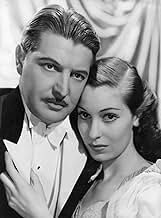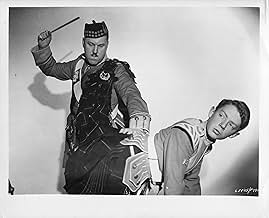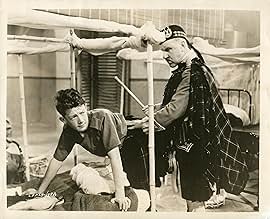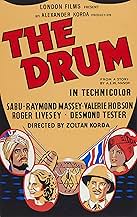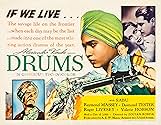IMDb RATING
6.3/10
997
YOUR RATING
In British India, Captain Carruthers investigates arms smuggling on the North West Frontier. The governor makes peace with Tokot's ruler. Prince Azim bonds with Carruthers and learns drums f... Read allIn British India, Captain Carruthers investigates arms smuggling on the North West Frontier. The governor makes peace with Tokot's ruler. Prince Azim bonds with Carruthers and learns drums from British boy Bill Holder.In British India, Captain Carruthers investigates arms smuggling on the North West Frontier. The governor makes peace with Tokot's ruler. Prince Azim bonds with Carruthers and learns drums from British boy Bill Holder.
- Awards
- 1 win & 1 nomination total
Francis L. Sullivan
- Governor
- (as Francis L.Sullivan)
Laurence Baskcomb
- Zarullah
- (as Lawrence Baskcomb)
Julien Mitchell
- Sergeant
- (as Julian Mitchell)
Featured reviews
From 'Kim' to 'Carry On up the Khyber', from the famous to the infamous (stand up, Harry Flashman!), the North-West Frontier has proved a fertile source of conflict both fictional and historical... and deposed rulers and fiery mullahs have figured largely from that day to this. The plot of 'The Drum' cribs heavily (and at one point openly, with an impudently-inserted piece of dialogue listing the historical parallels that had been niggling at me!) from real-life events, especially in Afghanistan, and as other stories before and since have been based on the same material, this can result in a certain 'seen-it-all-before' sensation. But the winning element in this film is the touch of humanity and humour which helps the characters to become more than cardboard templates, from the drummer-boy and his misfortunes to the wry jests of the newly-appointed British representative walking open-eyed into a trap. Not to mention that, after a spate of films with seemingly pointless titles, I found it obscurely satisfying to encounter one where the eponymous instrument is actually significant both to the plot and its climax!
The always-excellent Sabu steals the film, as ever, in his role first as a self-possessed princeling and then as a fugitive in exile from his throne; the romantic leads, while well-performed, are less memorable. The tension in the banquet scene is tangible, and Raymond Massey as the usurper brings brains as well as menace to his role. The one element that rather shocked me -- with the exception of the inadvertent glimpse of buttock that reveals exactly what Scotsmen do or don't wear under their kilts! -- was the scene in which the said usurper is shot down by our wounded hero in cold blood, having thrown down his weapon. It's not customary for such an act to be depicted in an apparently approving manner; and certainly not in a film of this period...
I must admit that the question of the period itself had me slightly puzzled, although the mention of syncopation in the drum part for the dance should have given me a clue. I had automatically assumed the story to be set in nineteenth-century India in the heyday of the Raj rather than the contemporary world, and with few European civilian fashions on display, there was nothing to disabuse me of this until the heroine made an appearance in jodhpurs, which came as something of a shock! (And the subconscious resonance with the valleys of 'Carry On up the Khyber' turns out to be based in fact: locations from both were shot in Wales...)
But 'The Drum' is a rousing adventure as they used to make 'em, in the tradition of 'Charge of the Light Brigade' or 'Northwest Frontier'; if you like the genre, this one is a cracker.
The always-excellent Sabu steals the film, as ever, in his role first as a self-possessed princeling and then as a fugitive in exile from his throne; the romantic leads, while well-performed, are less memorable. The tension in the banquet scene is tangible, and Raymond Massey as the usurper brings brains as well as menace to his role. The one element that rather shocked me -- with the exception of the inadvertent glimpse of buttock that reveals exactly what Scotsmen do or don't wear under their kilts! -- was the scene in which the said usurper is shot down by our wounded hero in cold blood, having thrown down his weapon. It's not customary for such an act to be depicted in an apparently approving manner; and certainly not in a film of this period...
I must admit that the question of the period itself had me slightly puzzled, although the mention of syncopation in the drum part for the dance should have given me a clue. I had automatically assumed the story to be set in nineteenth-century India in the heyday of the Raj rather than the contemporary world, and with few European civilian fashions on display, there was nothing to disabuse me of this until the heroine made an appearance in jodhpurs, which came as something of a shock! (And the subconscious resonance with the valleys of 'Carry On up the Khyber' turns out to be based in fact: locations from both were shot in Wales...)
But 'The Drum' is a rousing adventure as they used to make 'em, in the tradition of 'Charge of the Light Brigade' or 'Northwest Frontier'; if you like the genre, this one is a cracker.
The British are trying to make peace treaties with numerous tribes in India to make sure there isn't an uprising among rebel tribes. Captain Carruthers makes a treaty with the prince, but when the prince's brother (Prince Ghul) murders the prince, he now has the tribes just where he wants him (in a spot to annihilate the British). The murdered prince's son (Prince Azul) reaches Carruthers and tells him of what happened, so Carruthers takes a troop to Ghul's fortress. Ghul welcomes Carruthers with a ceremony of a 5 day feast, but when the feast is over Ghul plans to kill all the British troops with their smuggled machine guns, unless Azim can lead a British battalion to Tokot to stop Ghul's mad plan. Despite being politically incorrect with the British superiority over the people of India, the film does contain a fair amount of action and thrills to entertain the film going audience, granted it is no Gunga Din or Four Feathers (the latter of which and this film share the same author). Massey oozes evil as Ghul, and their is decent support with Sabu, youthful as ever as Azim, Massey as the stuffed shirt Carruthers, and Hobson as his wife. The score is decent, but not that rousing and shooting in color limited the best chances to use lighting. Rating, 7.
Great morale booster for the British people, with another World War looming. Shows the bonding between British and Indians that contributed to the long sojourn of the British in India. Definitely a boy's film with all the majesty that the Empire films of the thirties could muster for audiences suffering from economic depression and worries over the rise of fascism and its onward march. Roger Livesey's character brings to life the type of relationship that so many British civilians and civil servants enjoyed with Indians, so sadly ignored/forgotten in the interest of history revision and political correctness.
Unabashedly pro-Raj, the story of a young Indian Prince and his friendship with some British army types. The release of this film was reported to have sparked anti-British riots in India. Sabu outdoes himself as the spunky and, ultimately, obsequious Prince who lines up with his friend/occupiers to battle the deliciously evil Raymond Massey. Very politically incorrect by today's standards the film is a good adventure yarn as well as a Korda tribute to the the rapidly vanishing British Empire. The plot borrows elements from the real life killing of Sir Louis Cavagnari and his party years earlier in Afghanistan. In reality British and colonial forces were actively engaged in military operations in Waziristan at the time of the making of the film.
In colonial India, the natives live happily and peacefully under the kind rule of their British masters. Representing the bond between the two nations, young Prince Azim befriends several of the British officers. However his uncle Ghul is less welcoming of the British and has dark plans to slaughter them and raise a rebellion among the tribes of the hills.
Some critics have pointed to the fact that, if this film were made today, it work spark outrage and be roundly condemned. This view ignores that, when the film was first screened in India in the late 30's, it sparked riots among the populace. However, the statement is true as well as being null and void, for there is zero danger of this film ever being made now! The plot is very pro-Empire and it is brazenly flag waving for the British. Looking back now, the film is laughable in it's depiction of it's characters. The British are kind and loving to all the Indians they encounter, while the Indians love them in return; those that don't are, of course, shifty and untrustworthy.
This is rather insulting if you think about it too much - I must admit I wasn't offended but then I am neither English or Indian and know little of the history that is clearly being twisted here in favour of propaganda. The film does have a nice vein of good humour to it though that prevents it being too heavy, while the battle scenes are of the `up'n'over' school of filming. The plot itself is too simplistic and can't keep the charade up - especially now that it will be clear to most viewers that it isn't a fair telling.
The cast are good, but again, there's no way that an `Indian' film would be shot today in Wales with the majority of the cast in blackface! The standout actor is Sabu. True his character is a little too good to be true but he has cheeky attitude and he is good fun throughout - just a shame his character seem to vanish for about a quarter of the film. The villainous Massey is also good fun and I enjoyed his performance. The British (namely Livesey and Hobson) are very stiff, although they do get the more heroic roles towards the end.
Overall this film is worth seeing as we will hopefully not see quite it's like again. The film is un-PC in casting, script, plot and characters, while the history it claims to tell is nothing more than a flag waving exercise that rightly started angry riots in Indian when it was shown there. However it is worth seeing for the period, the glorious (for the time) Technicolor and an amusing and fun performance from Sabu.
Some critics have pointed to the fact that, if this film were made today, it work spark outrage and be roundly condemned. This view ignores that, when the film was first screened in India in the late 30's, it sparked riots among the populace. However, the statement is true as well as being null and void, for there is zero danger of this film ever being made now! The plot is very pro-Empire and it is brazenly flag waving for the British. Looking back now, the film is laughable in it's depiction of it's characters. The British are kind and loving to all the Indians they encounter, while the Indians love them in return; those that don't are, of course, shifty and untrustworthy.
This is rather insulting if you think about it too much - I must admit I wasn't offended but then I am neither English or Indian and know little of the history that is clearly being twisted here in favour of propaganda. The film does have a nice vein of good humour to it though that prevents it being too heavy, while the battle scenes are of the `up'n'over' school of filming. The plot itself is too simplistic and can't keep the charade up - especially now that it will be clear to most viewers that it isn't a fair telling.
The cast are good, but again, there's no way that an `Indian' film would be shot today in Wales with the majority of the cast in blackface! The standout actor is Sabu. True his character is a little too good to be true but he has cheeky attitude and he is good fun throughout - just a shame his character seem to vanish for about a quarter of the film. The villainous Massey is also good fun and I enjoyed his performance. The British (namely Livesey and Hobson) are very stiff, although they do get the more heroic roles towards the end.
Overall this film is worth seeing as we will hopefully not see quite it's like again. The film is un-PC in casting, script, plot and characters, while the history it claims to tell is nothing more than a flag waving exercise that rightly started angry riots in Indian when it was shown there. However it is worth seeing for the period, the glorious (for the time) Technicolor and an amusing and fun performance from Sabu.
Did you know
- TriviaThe film caused protests when shown in Bombay and Madras, as it was considered by many to be British propaganda.
- Alternate versionsVersion shown on Turner Classic Movies from "The Criterion Collection" runs 93 minutes
- ConnectionsFeatured in Family Classics: Family Classics: The Drum (1964)
- How long is The Drum?Powered by Alexa
Details
- Runtime
- 1h 44m(104 min)
- Aspect ratio
- 1.37 : 1
Contribute to this page
Suggest an edit or add missing content

